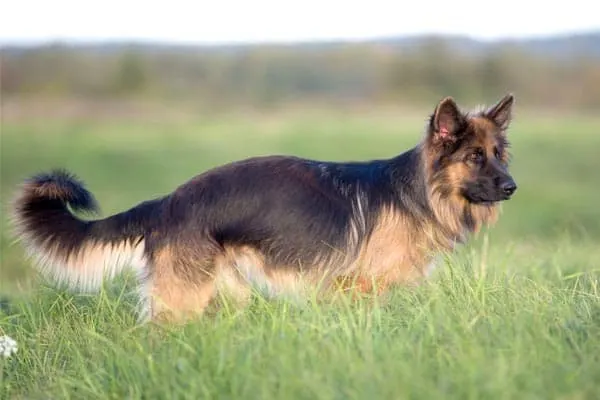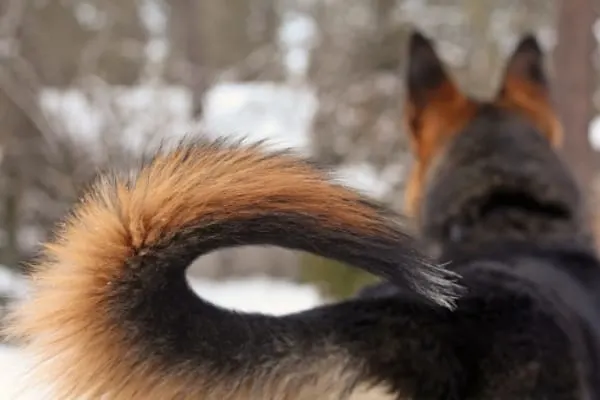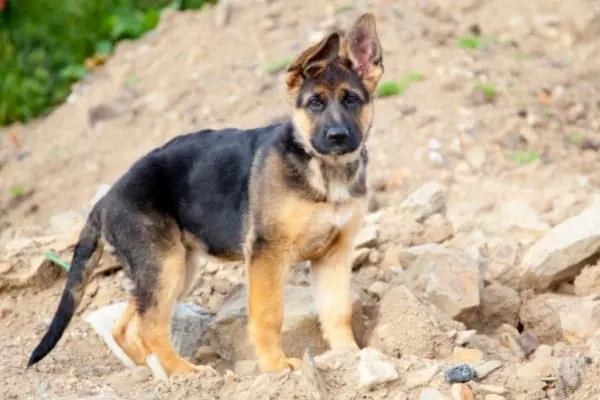When Do German Shepherd Tails Get Bushy: the Full Tale of the GSD Tail
The German Shepherd dog’s bushy tail is just one of the many unmistakable, iconic features of this beloved dog breed.
Thanks in large part to canine movie stars like Strongheart and Rin Tin Tin, people all over the world have fallen in love with the German Shepherd.
In fact, this dog is the second most popular purebred dog in the United States right now!
But German Shepherds haven’t earned their place in hearts all over the world just for their good looks.
These dogs are equally famous for their courageous roles as K-9 search and rescue, military, police, security, personal protection, service, and therapy dogs.
The fact that the German Shepherd comes with an adorable bushy tail is just like icing on the cake.
If you are caring for a German Shepherd puppy, you may be wondering when your adorable fluff ball is going to start looking more like a classic adult GSD – complete with a bushy tail.
We give you all the details of the GSD’s growth chart in this article.

Meet the World Famous German Shepherd Dog
The German Shepherd breed is actually a relatively recent purebred dog breed.
According to the German Shepherd Dog Club of America (GSDCA), in 1889, a German officer named Captain Max von Stephanitz saw a very unusual dog at a dog show.
The dog appeared to be half domestic canine and half-wild wolf. Intrigued and fascinated, von Stephanitz purchased the dog and launched a breeding program.
His goal was to create the perfect herding and livestock guard dog.
Today, this original dog is the founding father of all modern German Shepherd dogs all over the world.
While Captain von Stephanitz bred only for function and temperament and not for appearance, his original studbook (breeding record book) records at least three potential crosses between wild wolves and domestic dogs.
And of course, as Western Wildlife Outreach points out, wild wolves all have one singular feature – a long bushy tail. So this is likely where the modern German Shepherd dog has gotten their long bushy tail from.
Watch a German Shepherd Puppy Grow Up – and Grow In a Bushy Tail
German Shepherd dogs are considered to be in the large dog breed category.
This makes total sense, considering a mature adult German Shepherd can easily weigh up to 90 pounds and stand 26 inches tall (paw pads to shoulders).
If you have never cared for a large breed dog before now, you may not realize that large breed dogs mature more slowly than medium or small breed dogs.
This is because if a large breed dog grows too fast, it can put excess strain on the bones, muscles, and ligaments and lead to pain and malformation.
The German Shepherd may take anywhere from 18 to 36 months to complete their growth and become fully mature. This is why some new German Shepherd owners wonder if their little puppy will ever grow that long bushy tail!
In this sweet YouTube video, you can watch the maturation process of one adorable young German Shepherd puppy into a full-grown adult dog.

Why Is the Bushy Tail Important to the German Shepherd Dog Breed?
As the American Society for the Prevention of Cruelty to Animals (ASPCA) points out, the bushy tail is one of the traits most recognized about GSDs.
The tail is so important that it figures prominently in the German Shepherd’s official breed standard (appearance and conformation guidelines) registered with the American Kennel Club (AKC).
The official breed standard for the GSD specifies exactly what the German Shepherd dog’s tail should look like in adulthood. Here are the main points outlined in the breed standard:
- The tail should be bushy.
- The tail should extend out to the hock joint (be held away from the body to where it is parallel with the ankle joint).
- The tail should hang in a slight curve “like a saber.”
- The tail must not be short or docked (cut).
Dog owners who want to show their German Shepherd in dog shows or conformation competitions risk being disqualified or having points deducted if their dog isn’t able to meet every appearance guideline in the breed standard.
Did You Know the GSD Has Different Breed Lines?
While on the one hand, every German Shepherd dog alive today can trace its lineage back to the original Captain von Stephanitz dog breed line to some degree, there has also been quite a bit of divergence in modern GSD breeding.
There are two main distinctions in today’s German Shepherds: the show line and the working dog line.
As one German Shepherd breeder specifies, there are five sub-types from these two main lines:
- American show GSD.
- West German show GSD.
- West German working GSD.
- Czech working GSD.
- DDR (Deutsches Demokratische Republik) / East German working GSD.
This is important to know if you are purchasing a German Shepherd dog for a specific purpose or goal.
For example, let’s say you want to show your GSD in competitions for conformation.
In this case, you would be smart to choose a breeder that specializes in either the American or West German show GSD breed line.
This is because show lines are bred for appearance and conformation. These are the dogs that are most likely to grow up and develop the trademark German Shepherd’s long bushy tail.
In contrast, working GSD lines are bred for personality and temperament traits. Appearance is always secondary.
As you can see in these photos from the breeder cited here earlier, the working dog breed lines typically have thinner tails and sometimes the tails are curled, which could result in points off or disqualification in the show dog ring.

When Will a GSD Puppy Tail Get Bushy?
Earlier here we mentioned that German Shepherds as a general rule can take a longer period of time to mature. As this German Shepherd owner forum thread indicates, this can really confuse GSD owners.
The best way to know how long your German Shepherd will take to reach their full adult size and conformation is to learn as much as you can about the parent dogs.
As the official GSD breed standard explains, adult German Shepherds can range in size from 65 to 90 pounds and stand anywhere from 22 to 26 inches tall (paw pads to shoulders).
As well, depending on the breed line your GSD puppy comes from, it can take anywhere from 18 months to 36 months to fully mature.
This is important to know because the larger your puppy’s parents are, the longer your pup is likely to take to reach their full adult size, weight, coat, and tail.
As well, the breed line can influence the time to maturity, with the East German and Czech lines taking the longest in general to mature.
If your GSD puppy has reached a year and a half old and the tail still isn’t bushy like you expected, it may be that your dog comes from a breed line or from parents that do not have the big bushy, fluffy tail trait.
Alternately, it could be that your puppy just comes from a breed line that takes longer to mature and you have a bit longer to wait before that fluffy, bushy tail fully grows in.

The German Shepherd Puppy Coat Is Quite Different Than the GSD Adult Coat
Something else many first-time German Shepherd owners do not realize is that the German Shepherd puppy coat is quite different than the coat these dogs will have in adulthood.
The puppy coat is much softer and fluffier. It is also single-layer and is missing the second insulating under-layer these dogs grow as adults.
The puppy coat will start to shed out around the four to the six-month mark. The shedding out period signals the start of the adult coat growing in.
The adult German Shepherd coat is double layer. There is a longer, coarse, water-resistant outer layer that ranges from medium to long. Then there is the insulating, soft inner layer that lays close to the skin.
When the puppy coat begins to shed out, this is the time when you can expect to see your young GSD’s tail getting longer and thicker as well.
However, this whole process can take some time and depend in size and breed line, as we emphasized here earlier.
Every year thereafter, your German Shepherd will do something epic called “blowing coat” once to twice a year. This often happens at the changing of the seasons.
When the weather changes from winter to spring or fall to winter, this prompts the insulating under the layer of your dog’s coat to completely shed out and regrow.
This is very important for your dog’s protection but can temporarily produce a very thin tail.
This is not anything to worry about. Your dog’s thick, bushy tail will soon grow back as the new coat grows in.



















